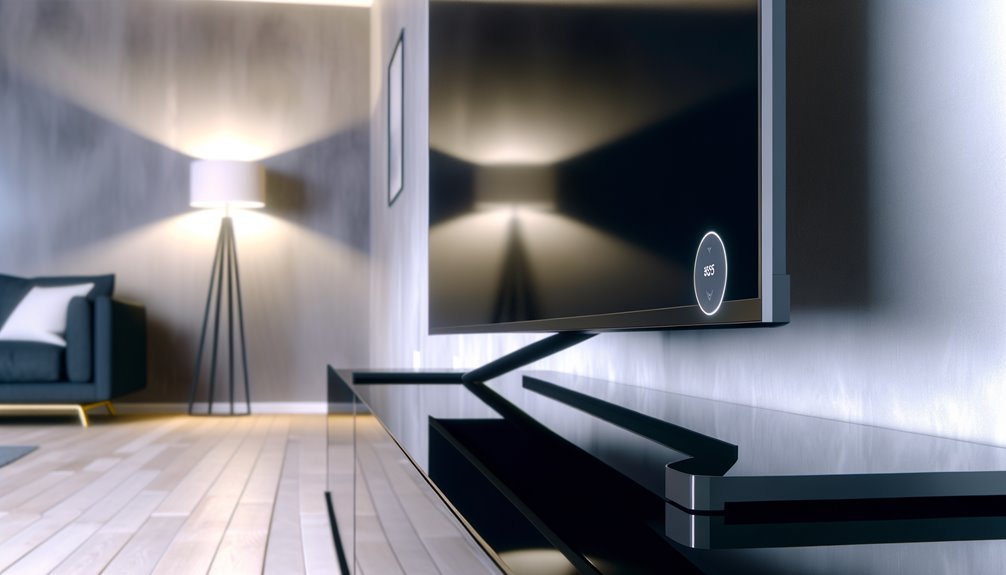So, can you use a TV as a computer monitor? You can if it meets certain compatibility and setup requirements.
HDMI and VGA cables are the best options for connecting your TV to your computer. Make sure the cable length is appropriate and matches the ports.
Adjust your display settings to maximise performance, considering resolution and refresh rates to avoid text blurriness and input lag.
TVs offer a larger screen and superior picture quality, but they may lack ergonomic features and could impact responsiveness.
To make the most of this setup, explore best settings and consider practicality aspects for your needs. Stay tuned to uncover more insights.
Key Information
- TVs can be used as computer monitors if they have compatible HDMI or VGA ports.
- Ensure the TV’s resolution and refresh rate match your computer’s capabilities for optimal performance.
- Using a TV provides a larger screen for enhanced multitasking and entertainment experiences.
- Potential downsides include input lag, text blurriness, and lack of ergonomic features.
- Adjust display settings like brightness, contrast, and color for better readability and comfort.
Connectivity Options
When considering connectivity options for using a TV as a computer monitor, you’ll typically rely on HDMI and VGA cables due to their widespread availability and compatibility.
HDMI cables are preferred for their ability to support high-definition video and audio through a single cable, ensuring a seamless multimedia experience.
VGA cables, though older, still offer reliable video connections but lack audio support, necessitating separate audio cables.
Some newer TVs also feature USB ports that allow for direct connections to computers, adding flexibility.
Always confirm compatibility between your TV and computer ports. Additionally, check that the cable length is adequate for your setup, ensuring proper positioning and functionality.
This initial step is important for achieving optimal display performance and clarity.
Setup Guide
To set up your TV as a computer monitor, first connect the two devices using either an HDMI or VGA cable, making sure both are securely plugged into the appropriate ports.
Next, adjust your display settings for best performance. Access your computer’s display settings to select the TV as the primary or secondary monitor, making sure the resolution matches the TV’s capabilities.
Consider the following:
- Cable Length: Make sure your cable is long enough to comfortably connect your computer to your TV without strain.
- Port Compatibility: Verify your TV and computer have compatible ports; use adapters if necessary.
- Input Source: On your TV, switch the input source to the corresponding port (HDMI1, HDMI2, etc.).
Advantages
Additionally, markedly leveraging a TV as a computer monitor can deliver a cost-effective and expansive display solution, especially if you already own a high-definition television.
TVs typically offer larger screen real estate compared to traditional computer monitors, which greatly enhances multitasking capabilities.
You can simultaneously manage multiple windows, improving productivity.
High-definition TVs also often boast superior picture quality, enriching your user experience for both work and entertainment.
They can provide an immersive environment for gaming and movies, thanks to their larger display sizes.
Using a TV as a computer monitor presents a versatile option, allowing you to seamlessly switch between professional tasks and leisure activities on a single screen, optimising your workspace and lifestyle integration.
Disadvantages
Utilising a TV as a computer monitor can have a notable impact on input lag, which diminishes responsiveness and may hinder tasks or gaming experiences.
Beyond this, several other disadvantages can affect your overall experience.
Lower resolutions on some TVs can lead to text blurriness, reducing readability and image quality.
Additionally, TVs often lack ergonomic features like tilt and height adjustment, causing potential discomfort during prolonged use.
Here are three key disadvantages:
- Input Lag: Reduces responsiveness, affecting tasks and gaming.
- Text Blurriness: Lower resolution TVs can make text hard to read.
- Lack of Ergonomics: Absence of adjustability can lead to discomfort.
These factors can have a significant impact on the practicality of using a TV as a computer monitor.
Optimisation Tips
Despite the disadvantages, there are several optimisation techniques you can employ to enhance your experience when using a TV as a computer monitor.
Adjust the brightness, contrast, and color settings to optimise the display for extended screen time. Set the appropriate refresh rate to minimise input lag and boost responsiveness, essential for gaming and real-time applications.
Experiment with different resolutions, ideally 1080p or 4K, to find an ideal balance of clarity and performance. Customise these settings based on your usage, whether for work or entertainment.
Each TV model has unique settings, so tweaking them according to your preferences will yield the best results. This in-depth optimisation ensures your TV functions effectively as a computer monitor.
Frequently Asked Questions
Is It Safe to Use a TV as a Computer Monitor?
You can safely use a TV as a computer monitor if it has HDMI or VGA ports. Confirm that your graphics card matches the TV’s resolution. Be aware of potential input lag and use game mode to mitigate it.
What Are the Disadvantages of Using a TV as a Monitor?
You’ll face input lag, text blurriness, and lack of ergonomic features. TVs often don’t support high resolutions and can limit display quality. Always research specific models for compatibility with computer use to avoid these issues.
Can I Use a Normal TV as a PC Monitor?
You can use a normal TV as a PC monitor if it has compatible input ports like HDMI. Confirm it supports 4:4:4 chroma subsampling for clear text, and check for input lag, especially in gaming scenarios.
Which TV Can Be Used as a Monitor?
You should choose a TV with HDMI 2.1, 4:4:4 chroma subsampling, and high refresh rates like 120Hz for peak performance. Models compatible with Nvidia’s GeForce RTX 30-series will provide the best experience for both gaming and productivity.
Conclusion
Ultimately, using a TV as a computer monitor is feasible if you understand the connectivity options and follow the setup guide meticulously.
While the larger screen size and potential cost savings are notable advantages, consider the disadvantages like input lag and lower pixel density.
Optimise your settings for the best experience. By weighing these factors, you can make an informed decision that suits your specific needs, ensuring a seamless integration between your TV and computer.



